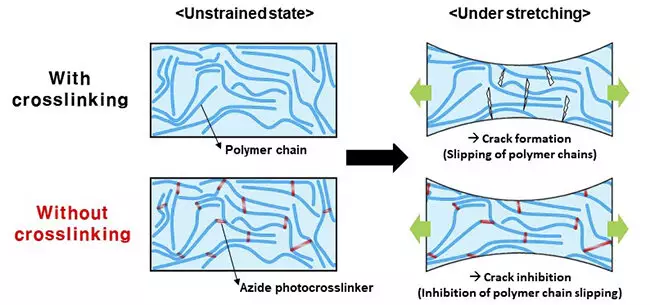In a recent study published in the Advanced Functional Materials journal, a joint team of researchers from the Department of Chemical Engineering at POSTECH and the Department of Nano Engineering at Sungkyunkwan University (SKKU) have developed a technology for high-performance organic polymer semiconductors that exhibit both stretchability and electrical functionality. The team was led by Professor Kilwon Cho, along with Ph.D. candidates Seung Hyun Kim and Sein Chung, and Professor Boseok Kang.
Challenges in Developing Stretchable Semiconductors
For semiconductors to be used in flexible devices like skin-attachable medical devices and flexible displays, it is necessary to use stretchable materials instead of rigid ones. However, the force exerted during the stretching of semiconductors can be up to ten times greater than that experienced during simple bending, leading to the breakdown of the semiconductor layers and a decline in their electrical performance. Researchers have been exploring methods to preserve semiconductor performance even under deformation, but a definitive solution to this challenge remains elusive.
The Solution: Molecular Brake
The research team successfully created a flexible molecular photocrosslinker featuring azide-reactive groups at both ends. When exposed to ultraviolet light, this photocrosslinker forms a network structure with the polymer semiconductor, acting as a brake that prevents slipping even under stretching conditions. This molecular brake allows the polymer chains to retain their stretchability and performance without any slipping.
The research team preserved up to 96 percent of the electrical performance of the polymer semiconductor, even when it was stretched to 80 percent. Moreover, the semiconductor exhibited significantly enhanced stretchability and durability compared to conventional semiconductors, clearly demonstrating the effectiveness of the developed technology.
The incorporation of azide photocrosslinkers into the films significantly enhances the stretchability and UV-patternability of organic semiconducting polymers, making it highly valuable for industries requiring large-area production and photolithography for the development of next-generation flexible electronics.
Professor Kilwon Cho said, “This simple approach significantly enhances the stretchability and UV-patternability of organic semiconducting polymers, making it highly valuable for industries requiring large-area production and photolithography for the development of next-generation flexible electronics. By incorporating azide photocrosslinkers into the films, we have successfully preserved the excellent electrical properties of polymer semiconductors for organic thin-film transistors even under significant mechanical deformation.”
This breakthrough in the development of stretchable semiconductors using a molecular brake paves the way for the creation of more groundbreaking flexible devices in various industries.


Leave a Reply